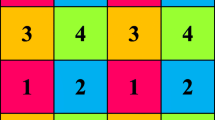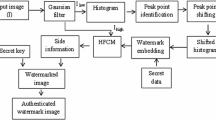Abstract
The exact retrieval of both i.e., watermark and host data using reversible watermarking makes it more suitable for applications like medical, military etc. The techniques which are considered most efficient and are being most widely used to implement it (reversible watermarking) are Prediction Error Expansion and Histogram Shifting as they offer higher embedding capacity with lesser distortion. The methodology proposed in this work is a hybrid one that utilizes the best of both. The algorithm starts with splitting the image into two regions and further processing is done on them one by one thereby covering each pixel for embedding thus amounting to enhanced capacity. The proposed work exploits the histogram of prediction errors instead of difference of adjacent pixels as it is more sharply distributed. This leads to lesser distortion in watermarked image. In this paper, the sorting of prediction errors is done in accordance with the calculated variance values of their prediction context followed by pairwise payload embedding. The results have substantiated the fact that for the smaller variance, prediction errors are also small. The proposed methodology is tested against the standard test images and real life applications such as medical, biomedical, aerial, military and colour images of Kodak image dataset. The experimental results demonstrate the superiority of the proposed work over the existing ones in terms of embedding capacity and distortion.















Similar content being viewed by others
Data Availability
The authors have taken the images from the following Image Databases for the proposed work:
1. USC-SIPI Image Database available online at: https://sipi.usc.edu/database/
2. CVG-UGR Image Database available online at : https://ccia.ugr.es/cvg/dbimagenes/index.php
3. hlevkin Image Database available online at: http://www.hlevkin.com/hlevkin/06testimages.htm
4. Kodak Image Database available online at: http://r0k.us/graphics/kodak/
References
Abdulla A A (2015) Exploiting similarities between secret and cover images for improved embedding efficiency and security in digital steganography. The University of Buckingham, UK
Agilandeeswari L, Ganesan K (2016) A robust color video watermarking scheme based on hybrid embedding techniques. Multimed Tools Appl 75:8745–8780. Springer
Agilandeeswari L, Ganesan K (2016) An efficient hilbert and integer wavelet transform based video watermarking. J Eng Sci Technol 11:327–345
Agilandeeswari L, Ganesan K (2018) RST invariant robust video watermarking algorithm using quaternion curvelet transform. Multimed Tools Appl 77:25431–25474. Springer
Ahmaderaghi B, Kurugollu F, Rincon J M D et al (2018) Blind image watermark detection algorithm based on discrete shearlet transform using statistical decision theory. IEEE Trans Comput Imaging 4:46–59
Celik M U, Sharma G, Tekalp A M et al (2005) Lossless generalized-LSB data embedding. IEEE Trans Image Process 14:253–266
Chang C S, Shen J J (2017) Features classification forest: a novel development that is adaptable to robust blind watermarking techniques. IEEE Trans Image Process 26:3921–3935
Dragoi I C, Coltuc D (2016) Adaptive pairing reversible watermarking. IEEE Trans Image Process 25:2420–2422
Fallahpour M (2008) Reversible image data hiding based on gradient adjusted prediction. IEICE Electron Express 5:870–876
Feng B, Yu B, Yilin B, et al. (2019) A reversible watermark with a new overflow solution. IEEE Access 7:28031–28043
Hong W, Chen T S, Shiu C W (2009) Reversible data hiding for high quality images using modification of prediction errors. J Syst Softw 82:1833–1842
Honsinger C W, Jones P W, Rabbani M et al (2001) Lossless recovery of an original image containing embedded data. U.S. Patent No. 6,278,791
Hu J, Li T R (2015) Reversible steganography using extended image interpolation technique. Comput Elect Eng 46:447–455
Ishtiaq M, Ali W, Shahzad W et al (2018) Hybrid predictor based four-phase adaptive reversible watermarking. IEEE Access 6:13213–13230
Jung K H (2018) A survey of interpolation-based reversible data hiding methods. Multimed Tools Appl 77:7795–7810. Springer
Khan A, Siddiqa A, Munib S et al (2014) A recent survey of reversible watermarking techniques. Inform Sci 279:251–272. Elsevier
Kouhi A, Sedaaghi M H (2022) Reversible data hiding based on high fidelity prediction scheme for reducing the number of invalid modifications. Inf Sci 589:46–61
Lee C F, Chen H L (2012) Adjustable prediction-based reversible data hiding. Digit Signal Process 22:941–953
Li Y C, Yeh C M, Chang C C (2010) Data hiding based on the similarity between neighboring pixels with reversibility. Digit Signal Process 20:1116–1128
Li X, Zhang W, Gui X et al (2016) Efficient reversible data hiding based on multiple histograms modification. IEEE Trans Inf Forensics Sec 10:2016–2027
Lin C C, Tai W L, Chang C C (2008) Multilevel reversible data hiding based on histogram modification of difference images. Pattern Recognit 41:3582–3591. Elsevier
Mandal P C, Mukherjee I, Paul G, Chatterji B N (2022) Digital image steganography: a literature survey. Inform Sci 609:1451–1488. Elsevier
Memon N A, Khan A, Gilani S A M et al (2011) Reversible watermarking method based on adaptive thresholding and companding technique. Int J Comput Math 88:1573–1594
Naskar R, Chakraborty R S (2012) Reversible Watermarking utilising weighted median-based prediction. IET Image Process 6:50–520
Ni Z, Shi Y Q, Ansari N et al (2006) Reversible data hiding. IEEE Trans Circ Syst Video Technol 16:354–362
Ortiz A M, Uribe C F, Beltran R H et al (2019) A survey on reversible watermarking for multimedia content: a robustness review. IEEE Access 7:132662–132681
Ou B, Li X, Zhao Y et al (2013) Pairwise prediction-error expansion for efficient reversible data hiding. IEEE Trans Image Process 22:5010–5021
Ou B, Li X, Wang J (2016) High-fidelity reversible data hiding based on pixel-value-ordering and pairwise prediction-error expansion. J Vis Commun Image Represent 39:12–23. Elsevier
Poonam, Arora S M (2018) A DWT-SVD based robust digital watermarking for digital images. Procedia Comput Sci 132:1441–1448. Elsevier
Rad RM, Wong KS, Guo JM (2016) Reversible data hiding by adaptive group modification on histogram of prediction errors. Signal Process 125:315–328. Elsevier
Sachnev V, Kim H J, Nam J et al (2009) Reversible watermarking algorithm using sorting and prediction. IEEE Trans Circ Syst Video Technol 19:989–999
Samee R, Riaz M M, Ghafoor A (2018) Adaptive interpolation and segmentation based reversible image watermarking. Multimed Tools Appl 77:26821–26843. Springer
Tai W L, Yeh C M, Chang C C (2009) Reversible data hiding based on histogram modification of pixel differences. IEEE Trans Circ Syst Video Technol 19:906–910
Thodi D M, Rodriguez J J (2007) Expansion embedding techniques for reversible watermarking. IEEE Trans Image Process 16:721–30
Tian J (2003) Reversible data embedding using a difference expansion. IEEE Trans Circ Syst Video Technol 13:890–896
Wahed M A, Nyeem H (2019) High capacity reversible data hiding with interpolation and adaptive embedding. PLOs ONE 14:Art. no e0212093
**ong X (2019) Novel scheme of reversible watermarking with a complementary embedding strategy. IEEE Access 7:136592–136603
Yang C H, Tsai M H (2010) Improving histogram-based reversible data hiding by interleaving predictions. IET Image Process 4:223–234
Yanga C N, Hsua S C, Kim C (2017) Improving stego image quality in image interpolation based data hiding, vol 50
Zhang C, Ou B (2021) Reversible data hiding based on multiple adaptive two-dimensional prediction-error histograms modification. IEEE Trans Circ Syst Video Technol. https://doi.org/10.1109/TCSVT.2021.3125711
Zhou J, Au OC (2012) Determining the capacity parameters in PEE-based reversible image watermarking. IEEE Signal Proc Lett 19:287–290
Author information
Authors and Affiliations
Corresponding author
Ethics declarations
Competing interests
The authors declare that they do not have any competing financial interests nor any personal relationships that could seem o have influenced the work presented in this paper.
Additional information
Publisher’s note
Springer Nature remains neutral with regard to jurisdictional claims in published maps and institutional affiliations.
Rights and permissions
Springer Nature or its licensor (e.g. a society or other partner) holds exclusive rights to this article under a publishing agreement with the author(s) or other rightsholder(s); author self-archiving of the accepted manuscript version of this article is solely governed by the terms of such publishing agreement and applicable law.
About this article
Cite this article
Tanwar, L., Panda, J. Hybrid reversible watermarking algorithm using histogram shifting and pairwise prediction error expansion. Multimed Tools Appl 83, 22075–22097 (2024). https://doi.org/10.1007/s11042-023-15508-5
Received:
Revised:
Accepted:
Published:
Issue Date:
DOI: https://doi.org/10.1007/s11042-023-15508-5




